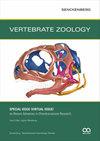两种新的刺蟾属(无尾目:蟾科)突出了安哥拉特有种中心的重要性
IF 2.3
2区 生物学
Q1 ZOOLOGY
引用次数: 0
摘要
侏儒蟾蜍属Poyntonophrynus是非洲南部特有的。这些小蟾蜍的形态是保守的。它们通常颜色暗淡,主要适应干旱条件。在最近对安哥拉的调查中,我们发现了不能归属于已知物种的波氏舌鱼标本。采用基于线粒体和核DNA、形态学、骨学、生物地理学和生态学的综合方法,我们确定了三个新的谱系,并将其中两个描述为新种。所有三个谱系都与安哥拉特有物种pachnodes密切相关,但它们在地理上与之隔离。新物种在形态上是可区分的,并且与安哥拉两个最重要的特有中心有关:西部悬崖和中央高地。为了对该属的骨学有更全面的了解,我们还提供了迄今为止尚未获得的P. dombensis的骨学特征。我们的发现i)增加了Poyntonophrynus属无耳物种的数量,ii)强调非洲西南部是该属多样化的摇篮,iii)报告了Poyntonophrynus在潮湿环境中的发生,从而表明这些蟾蜍在生态上比以前认为的更多变,iv)强调了在安哥拉特有中心进一步开展生物多样性研究的重要性。本文章由计算机程序翻译,如有差异,请以英文原文为准。
Two new Poyntonophrynus species (Anura: Bufonidae) highlight the importance of Angolan centers of endemism
Abstract The pygmy toad genus Poyntonophrynus is endemic to southern Africa. The morphology of these small toads is conserved. They are usually dully colored, and are predominately adapted to arid conditions. During recent surveys in Angola we found Poyntonophrynus specimens that were not assignable to known species. Using an integrative approach, based on mitochondrial and nuclear DNA, morphology, osteology, biogeography and ecology, we identified three new lineages, and describe two of them as new species. All three lineages are closely related to P. pachnodes , an Angolan endemic species, but they are geographically isolated from it. The new species are morphologically distinguishable, and are associated with two of the most important Angolan centers of endemism: the western escarpment and the central highlands. In order to get a more comprehensive understanding of the osteology of the genus, we also provide an osteological characterization of P. dombensis , which was not available to date. Our findings i) increase the number of earless species in the genus Poyntonophrynus , ii) emphasize southwestern Africa as the cradle of diversification in this genus, iii) report the occurrence of Poyntonophrynus in humid environments, thus showing that these toads are ecologically more variable than previously thought, and iv) underline the importance of further biodiversity studies in Angolan centers of endemism.
求助全文
通过发布文献求助,成功后即可免费获取论文全文。
去求助
来源期刊

Vertebrate Zoology
ZOOLOGY-
CiteScore
4.00
自引率
19.00%
发文量
42
审稿时长
>12 weeks
期刊介绍:
Research fields covered by VERTEBRATE ZOOLOGY are taxonomy, morphology, anatomy, phylogeny (molecular and morphology-based), historical biogeography, and palaeontology of vertebrates.
 求助内容:
求助内容: 应助结果提醒方式:
应助结果提醒方式:


